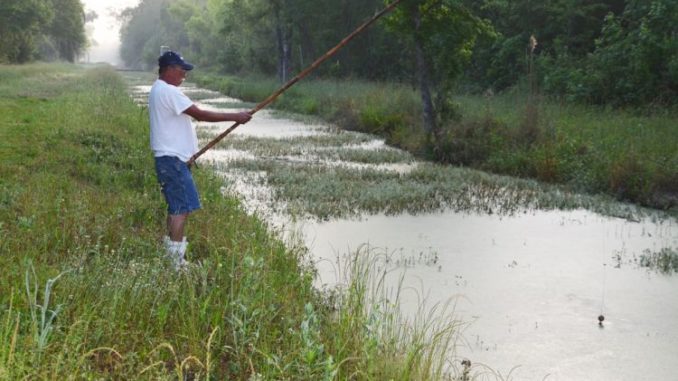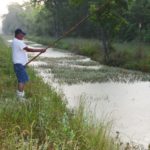
Everything you need to know to target the delicious — but very much underappreciated — choupique
The thrashing dinosaur was yanked out of the water, flew high over the lanky man’s head and landed with a thud in the tall weeds. It immediately began slithering through the wet grass back toward the weedy canal.
Mike Lirette wasted no time in straddling it on his knees and holding its slimy body in a mortal lock. With the fish under control, he held it up for my inspection. In the background, his nephew Dale Lirette looked on approvingly.
“Every chance I get, I go choupique,” he boomed. “I love to eat them; I love to catch them.
“My wife loves to fish choupique. I got three girls and a boy and they all choupique.”
The choupique (pronounced shoe-pick) he was referring to is the same creature that biologists call “bowfin” and North Louisianans call “grinnel.” Bass fishermen loathe them, too often slamming the hook home on what they think is a tournament-winning fish, only to find that the ferocious fight is being delivered by a lowly choupique.
Mike chuckled at their prejudices. “I find choupique is a tender fish to eat. It’s easy to clean. You got more meat on a choupique than any other fish.”
“But you got to keep them alive until you clean them,” chimed in Dale. “If they die they get mushy — oh lord yeah. They get mushy like a white trout.”
The two men traveled to their fishing spot, a drainage canal on the backside of Lafourche Crossing on the Highway 308 side of Bayou Lafourche, by pickup truck. This canal in turn tied into the 60 Arpent Canal
It didn’t look like much. It was maybe 20 feet wide, and while patches of open water existed here or there, most of it was overgrown with rooted vegetation or covered with floating duckweed. It looked friendlier to tadpoles and snakes than any kind of fish.
But the Lirettes were confident. Before unlimbering their poles (they carried five to have three extras), one cut bream caught the day before on small hooks into bait-sized pieces and the other sorted through the bait crawfish bucket, discarding the dead ones.
The crawfish weren’t small, being big enough to boil. All morning Mike and Dale would alternate between the two baits, although the cut bream caught the most fish that day. Crawfish were threaded on the hook, starting under their head and through the tail.
They will often use other baits as well, including shrimp, beef heart, frogs, chicken gizzards, and salt meat. “They love salt meat,” croaked Dale.
“They will bite on anything, when they are hungry,” observed Mike pithily.
Dale scored first with a beautiful male. “You can tell it’s a male by the spot on the tail,” he grunted in explanation.
While cane poles and corks are used, choupique fishing is not a passive affair. The men worked actively to attract the fish to their baits. One technique involved dabbling their big corks up and down on the water’s surface, then allowing them to rest still for a few seconds to look for a bite.
“A choupique is like a barracuda,” one of them explained. “When it moves, they will hit it.”
Less frequently, but not rarely, when they felt more commotion was needed, one of them would vigorously thrash the surface of the water with the tip of his pole. Dale did this more often than Uncle Mike.
In spite of the heavy tackle and noisy fishing technique, choupique bites are remarkably subtle. The toothy predators seldom smashed the baits. Rather, they nibbled and played with the bait, sometimes it seemed for minutes.
Not until the big cork went under and the fish had swum all the slack out of the line did they strike. But when they did, they violently slammed the hook home.
It was easy to tell when Mike was working a fish. His body tensed up and he put both hands on his pole, which was normally propped on his hip and held with one hand. And he started sweet-talking the fish. “C’mon baby; take it; take it.”
Right before setting the hook, his body would go into a power crouch. Both men set the hook with massive overhead Herculean swings that arced the sizable fish over their heads and into the grass behind them.
“You wanna make sure you hook ‘em good,” grinned Dale in understatement.
Their strategy was simple. They would stop at a spot on the canal, seemingly at random, and fish it 15 or 20 minutes. If they didn’t get a bite, they quickly moved to another spot. Some spots drew blanks, but many spots yielded one or two fish.
At 11:30 a.m. I caught the signal from Mike.
“You gonna stay and eat some, eh? I got my friend Jerry Cortez and some family coming to eat choupique.
“Oh yeah!”
“Allons,” he said with finality. “Let’s go.”




